Patrolman David Lee with the Pensacola Police Department was conducting his routine patrol in the early morning hours of February 15, 1978, when he just happened to cross paths with Theodore Bundy when he stopped him for a traffic violation. After a slight scuffle in which Bundy tried to flee, Lee managed to handcuff and secure him inside his vehicle. Bundy was quiet for most of the ride, and he knew his criminal adventures were finally over.1 After two successful escapes from jail, there was not going to be an opportunity for another.2
“I wish you had killed me.” He told Lee from the back of the car. “Would you kill me if I tried to run?”3
Before Bundy’s killing spree began, he attended the University of Washington, where he obtained a Bachelors degree and two years of law school.4 Based on the knowledge he gained in law school, Bundy insisted on being directly involved in conducting his defense in each of his trials, which is where his legal downward spiral began. During his sentencing trial, he attempted to connect with his jury and humanize himself by using carefully chosen Bible scripture. He wanted his largely southern jury to see him as comparable to Christ. He assured them that he was no Christ figure, but he urged them to remember how Christ had experienced an unjust trial and was subsequently executed on the basis of that unjust trial.5

As his final trial started to come to its inevitable end, Bundy did everything he could to postpone his execution date. He had multiple interviews with several different individuals; in each interview he would reveal something about himself that he would use to charm or manipulate his audience. One of these interviews led to an examination of evidence to see if Bundy was incompetent at the time of trial, which postponed his sentencing hearing. When a reporter questioned Bundy in an attempt to get him to admit to the thirty suspected murders, Bundy replied, “Put a zero after that.”6 Though we will never be certain on an exact number of murders that Bundy committed, it is without a doubt higher than the thirty that he officially confessed to.

Finally, on January 17, 1989, Bundy’s fourth and final death warrant was signed.7 It was at this point that he started confessing to multiple murders in an attempt to stave off his execution. After having been able to squeeze his way out of nearly every other situation he had managed to entangle himself in, he finally started to realize the inescapable reality, and the mask that he put on to keep the world from seeing him for what he really was, started to slip. He immediately began to look for his way out, trying to tug at the heartstrings of anyone who would listen. His last card to play was his interview with James Dobson.8

Dr. James Dobson is the founder of Focus on the Family, a Christian organization based in Colorado.9 At the time of Bundy’s interview, Dr. Dobson’s campaign was that pornography and violence were interrelated, and since Bundy was looking for a way to keep people talking about him, they were a match made in heaven. Throughout the interview, Dr. Dobson and Bundy were able to craft an entirely new story that thousands of people would believe. Bundy was able to portray himself as being corrupted by pornography from a young age, that pornography is what caused his violent behavior. Dr. Dobson had his perfect poster child. There was a question in the middle of the interview in which Dr. Dobson questioned Bundy about the murder of Kimberly Leach, and Bundy stated that he couldn’t talk about it.
“One of the final murders that you committed, … little Kimberly Leach, 12 years of age. I think the public outcry was greater there because an innocent child was taken from a playground. What did you feel after that? Was there normal emotions three days later? Where were you, Ted?” asked Dr. Dobson.

“I can’t really talk about that,” said Ted Bundy.
“That’s too painful,” Dr. Dobson interjected.
“I would like to be able to convey what that experience is like, but I can’t be able to talk about it,” said Ted Bundy.
“OK,” said Dr. Dobson.10
At this point, the camera caught Bundy’s quick glance at Dr. Dobson, clearly reading and carefully considering his next words. It was at this moment that Bundy’s eyes looked up at Dr. Dobson and in those few seconds his mask slipped, revealing the heartless murderer making his cold calculations on what his next move would be. The facade of the repented sinner that was corrupted by pornography that Bundy had been attempting to convey to us crumbled to reveal the truth, a psychopathic killer.

Throughout the entire forty-minute interview, he carefully chose his words in order to most effectively charm whatever audience he could manage to get his words to. This interview is where we get one of his most infamous quotes:
“And people need to recognize it’s not some kind of . . . those of us who are or who have been so much influenced by violence in the media, in particular, pornographic violence, are not some kind of inherent monsters. We are your sons and we are your husbands, and we grew up in regular families. And pornography can reach out and snatch a kid out of any house today. It snatched me out of my home 20, 30 years ago, and as dedicated as my parents were, and they were diligent in protecting their children and as good a Christian home as we had, and we had a wonderful Christian home, there is no protection against the kind of influences that are loose in society that tolerates. . . .”11
Ann Rule, a former co-worker and friend of Bundy, immediately recognized the interview for what it was: a final attempt to save himself, to blame someone other than himself for what he did.
“Dr. Dobson wanted someone to testify against booze and pornography, and Ted wanted to leave us all talking about him. He wanted to blame someone else for his crimes, and by saying it was us who left all those bad magazines on the racks, he became innocent in his own mind.”12

On January 24, 1989, Theodore Bundy died in the electric chair. As the white flag signaling his death was waved from the prison yard, cheers could be heard from the crowd gathered across the street. The chant “Burn, Bundy, burn!” paired with the banging of frying pans rang out in the early morning air.13
Dr. Dobson did not release the interview until after Bundy was executed. In a way, both of these men achieved their goal. Dr. Dobson had a real-life example of the dangers that pornography can have on a perfectly “normal human.” Bundy was able to keep people talking about him, his horrific murders, and what possible factors led him to commit those crimes. Several women viewed Dr. Dobson’s interview with Bundy and saw the compassion and remorse that Bundy was attempting to portray, while others were able to see through his last lie.14 Bundy went down in history for being one of the most cold blooded killers who will continue to be discussed for generations.
Though many people still protest Bundy’s execution, there is one thing we can all agree on: “He had an easier death than any of his victims.” 13
- George R. Dekle, The Last Murder: The Investigation, Prosecution, and Execution of Ted Bundy: The Investigation, Prosecution, and Execution of Ted Bundy (Santa Barbara, California: Praeger, 2011), 16. ↵
- Kristen Iversen, “When Death Came to Golden,” American Scholar 87, no. 2. (2018): 82. ↵
- George R. Dekle, The Last Murder: The Investigation, Prosecution, and Execution of Ted Bundy: The Investigation, Prosecution, and Execution of Ted Bundy (Santa Barbara, California: Praeger, 2011), 16. ↵
- George R. Dekle, The Last Murder: The Investigation, Prosecution, and Execution of Ted Bundy: The Investigation, Prosecution, and Execution of Ted Bundy (Santa Barbara, California: Praeger, 2011), 22. ↵
- George R. Dekle, The Last Murder: The Investigation, Prosecution, and Execution of Ted Bundy: The Investigation, Prosecution, and Execution of Ted Bundy (Santa Barbara, California: Praeger, 2011), 212. ↵
- George R. Dekle, The Last Murder: The Investigation, Prosecution, and Execution of Ted Bundy: The Investigation, Prosecution, and Execution of Ted Bundy (Santa Barbara, California: Praeger, 2011), 219. ↵
- George R. Dekle, The Last Murder: The Investigation, Prosecution, and Execution of Ted Bundy: The Investigation, Prosecution, and Execution of Ted Bundy (Santa Barbara, California: Praeger, 2011), 218. ↵
- Kristen Iversen, “When Death Came to Golden,” American Scholar 87, no. 2. (2018): 88. ↵
- Dr. James Dobson Steps Down as Focus on the Family Chairman (Colorado Springs, Colorado: Focus on the Family. February 27, 2009), https://www.focusonthefamily.com/about/newsroom/news-releases/20090227-dobson-steps-down-as-focus-chairman. ↵
- The Associated Press,”Bundy’s Last Interview; ‘I take full responsibility,'” The Palm Beach Post, January 29, 1989, 7-8. ↵
- The Associated Press,”Bundy’s Last Interview; ‘I take full responsibility,'” The Palm Beach Post, January 29, 1989, 7-8. ↵
- LAST BUNDY INTERVIEW CALLED `CON GAME,’ Salt Lake City, Utah: Deseret News. September 12, 1989. ↵
- Barry Bearak, “Bundy Electrocuted After Night of Weeping, Praying : 500 Cheer Death of Murderer,” Los Angeles Times, 24 Jan. 1989. ↵
- LAST BUNDY INTERVIEW CALLED `CON GAME,’ Salt Lake City, Utah: Deseret News. September 12, 1989. ↵
- Barry Bearak, “Bundy Electrocuted After Night of Weeping, Praying : 500 Cheer Death of Murderer,” Los Angeles Times, 24 Jan. 1989. ↵



125 comments
Celeste Flores
I already knew about Ted Bundy before the article because my mom used to watch the TV-Show they made about his life. I do not like violence, I hate violence and everything related to that. Bundy was an expert on twisting minds and making people like him. Just as Hitler, and many murderers, he was extremely good with words. As I mentioned, I already knew about him, however, I never thought about the fact that pornography is visual violence. Unfortunately, pornography has been around for many years, and I do not think there is a way to stop it. We should focus on not letting this kind of violence at the hand of children who can be detrimentally affected by it.
Kristina Tijerina
It’s truly ridiculous the way that Ted Bundy lied to make himself seem innocent, or the way he portrayed himself to keep the media focused on him. He used the knowledge he gained in his two years of law school, and took advantage of every opportunity he found that would benefit him. His hopes to avoid the death sentence failed, but he was still talked about amongst the public. Dr. Dobson’s idea to say that pornography led to Bundy’s violence was a horrible excuse to use. Although Bundy got the death sentence and was no longer able to murder anymore innocent women, he did indeed get an easier death than that of his victims.
Malik Heard
Its crazy to think that this man killed thirty people and its believed he killed even more .Ted Bundy was a scary man because he felt nothing what so ever for the people he killed and the violent acts he committed .I don’t think the media should have given him the attention he wanted because that was his goal.How can a person that committed 30+ murders and not feel a thing be scared of the punishment that he was going to receive as a result of his actions.I
Saira Locke
The behavior that Ted Bundy portrayed is no different than any other cold-hearted murderer. It’s crazy to me that Ted Bundy tried his best to not receive punishment for his multiple murders because you would think that he would accept the punishment for his actions. I would think that while he was committing these horrendous murders, he thought about the chase of him getting caught and punished. He deserved to die just has horribly as all 30+ of his victims did but justice was still served.
Sabrina Doyon
It is ridiculous to me that anyone could say that por no graphy is what created Bundy’s lust for blood. He was born a crazy person. Yes, it may have given him an outlet for his crazy, but he was born with the lust. I think it is sad that he put on a show in life instead of just committing to being a crazy killer. I guess it makes for a better story when he is dead now. Overall, I really enjoyed learning a new piece to the puzzle and it is kind of wild how people made shirts to celebrate his death!
Amelia Hew
I read about the crimes Bundy committed over the years and I have to say that even till the last moment of his life he still wore the benevolent and innocent mask on his face to hide the cold-blooded person he really was. We won’t really know his reason for why he lied till the last moment of his life. Perhaps he’s still clinging on the last straw, hoping to escape execution by winning the empathy of his audience or was it that he refused to amid defeat despite being captured or maybe he wanted to be remembered forever? Whatever the reason was, he sort of achieved his goal and was known throughout the world as history’s most cold-blooded killer.
Angelina Gonzalez
I didn’t learn about Ted Bundy until the netflix series came out this year. I find it so shocking that this man was able to get away with apparently hundreds of murders, according his quote, “add a zero to that.” I also do not see how the jury kept delaying his death sentencing and he was able to fool the people that he was innocent. It is infuriating to me when I read these horrifying stories that occurred. In my opinion the electric chair was not a good punishment. What he did to so many people, little girls, is not forgivable, especially by the chair.
Andrea Degollado
Ive read countless articles about Ted Bundy and I have even seen the Netflix series about him and every time I read about him I am still shocked. I will never understand the reassigning for going on a killing spree, especially when it involves little girls. Ted Bundy is a great example of a heartless murder, even on his last days he was still trying and managing to fool people and charm them.
Rosa Robledo Martinez
Ted Bundy is a very sick man. It’s crazy reading this article and reading how he would use his looks to prove that he is innocent. I noticed a lot of people know a lot about Ted Bundy’s story because of his documentary on Netflix, but I just cant imagine how people try to back him up because he looks attractive. I feel like his story allowed many people to understand his terrible acts and how he manipulated people. I just feel disgusted knowing what he did to many young females and still deny the truth.
Addie Piatz
I had heard Ted’s story but I loved how this article took one of the most iconic interviews in his story and expanded on it. I specifically liked the picture of him durning the interview where his persona changed completely. His “nice guy” face disappears. You truly see what kind of a person he really is until he catches himself and switches back to his deceiving act.